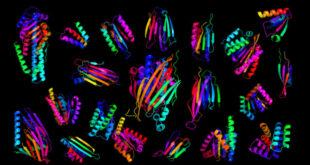May Halt COVID-19 Cytokine Storm
Cytokines are signaling proteins that stimulate inflammation and other immune responses. ‘Cytokine storm,’ or cytokine release syndrome, plays a critical role in viral infections such as COVID-19. This burst of immune overreaction damages the lungs and is potentially life-threatening. Therefore, efficient removal of excessive cytokines is essential for treatment. Now, researchers from MIT and Avalon GloboCare have developed specialized proteins that they believe could soak up excessive cytokines.
This rendering depicts the secretion of cytokines, the tiny pink bits, from a cell. Image credit: Scientificanimations.com / CC BY-SA 4.0.
“The idea is that they can be injected into the body and bind to the excessive cytokines as generated by the cytokine storm, removing the excessive cytokines and alleviating the symptoms from the infection,” said MIT research scientist Dr. Rui Qing, senior co-author of the study.
The team’s work on blocking cytokine storms grew out of a project aimed to develop modified versions of membrane-embedded proteins. These proteins are usually difficult to study because once they are extracted from the cell membrane, they only maintain their structure if they are suspended in special types of detergents.
After working on the problem for several years, the researchers developed a method for modifying the hydrophobic regions of these proteins, making them soluble in water and much easier to study.
Their method, called the QTY code, calls for replacing some hydrophobic amino acids with hydrophilic amino acids that have similar structures. Leucine is converted to glutamine, isoleucine and valine are converted to threonine, and phenylalanine is converted to tyrosine.
Following the development of the QTY code, the team focused water-soluble versions of proteins known as cytokine receptors. These receptors are found on the surface of immune cells, where they bind to cytokines.
The scientists believed that proteins that mimic these cytokine receptors could help combat cytokine storms, which can be produced by viral or bacterial infections, including HIV and hepatitis. They can also occur as a side effect of cancer immunotherapy.
In April 2019, the team set out to design proteins that could sop up these excess cytokines like a sponge. To do that, they used the QTY code to make water-soluble versions of cytokine receptors. When proteins are soluble in water, they can travel efficiently through the human bloodstream, while the original, hydrophobic versions of the proteins would likely stick to cells that they encountered.
The authors also attached an antibody segment called the Fc region to their water-soluble receptor proteins. This region helps to further stabilize the proteins in the bloodstream, and makes them less likely to be attacked by the immune system.
They designed proteins that mimic six different cytokine receptors, which can bind to cytokines such as interferon and interleukin, as well as a class of cytokines called chemokines.
In lab tests of the proteins’ binding strength, they found that their modified proteins were able to bind to cytokines with similar strength as naturally occurring cytokine receptors.
“The cytokine receptors that we designed will soak up the majority of the excessive cytokines that are released during the cytokine storm,” said co-author Dr. David Jin, CEO and president of Avalon GloboCare.
In March 2020, when evidence began to suggest that the SARS-CoV-2 virus was inducing cytokine storms in some patients, the researchers realized that the receptor proteins they had designed might be able to help.
They decided to quickly publish the results they have generated so far, and they are now planning to do additional tests in human cells and in animal models of COVID-19 infection.
“The potential usefulness of this approach underscores the importance of curiosity-driven research,” said MIT researcher Dr. Shuguang Zhang, senior co-author of the study.
“As it turns out, our research initiated in April 2019 is directly relevant to the treatment of COVID-19 infected patients. Curiosity-driven, or even proactive research often leads to preparedness, which is key to preventing future disasters.”
The team’s work appears in the journal Quarterly Review of Biophysics (QRB) Discovery.
_____
Shilei Hao et al. QTY code-designed water-soluble Fc-fusion cytokine receptors bind to their respective ligands. QRB Discovery, published online April 9, 2020; doi: 10.1017/qrd.2020.4
 #Bizwhiznetwork.com Innovation ΛI |Technology News
#Bizwhiznetwork.com Innovation ΛI |Technology News




